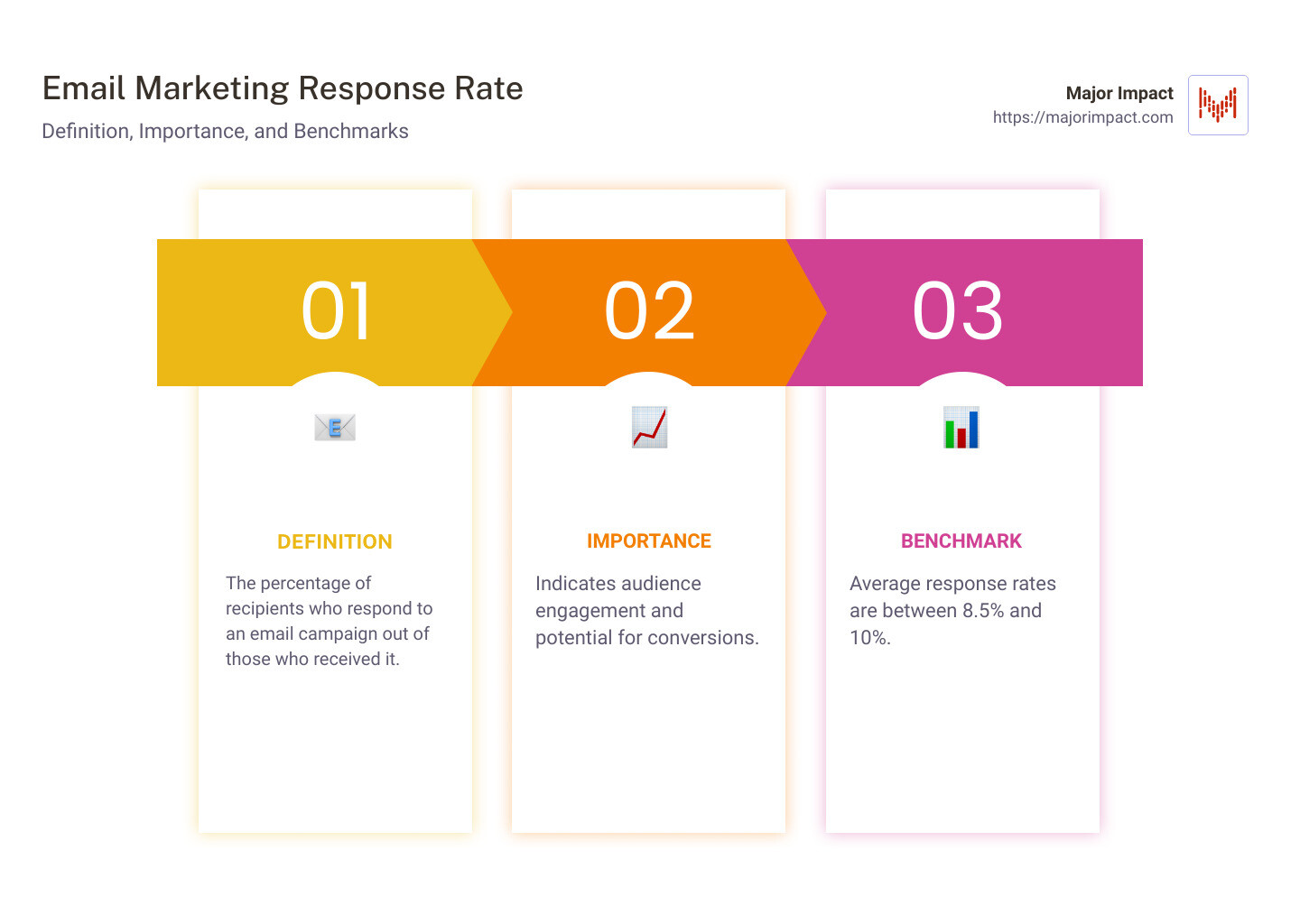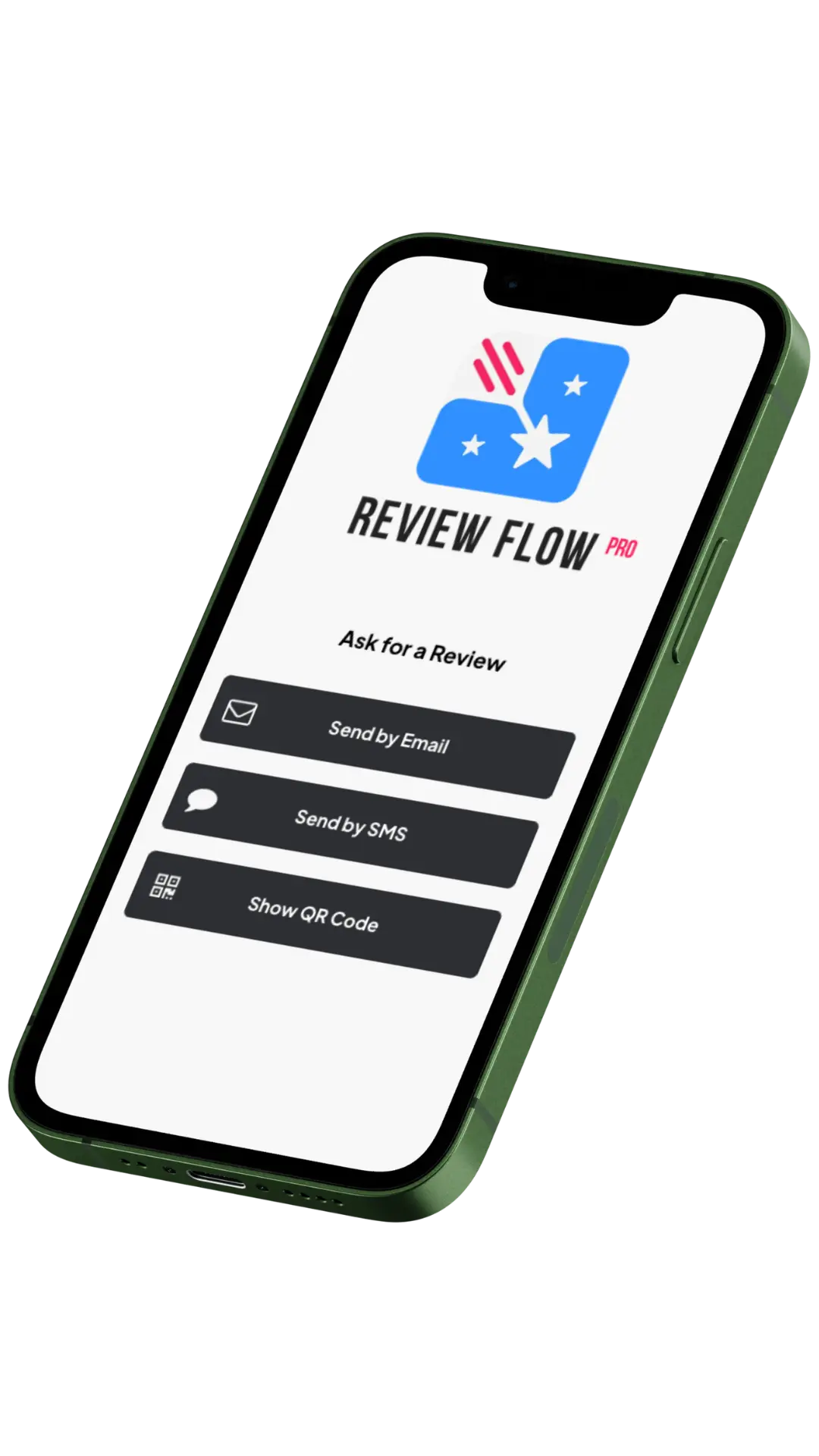Table of Contents
Why Email Marketing Response Rates Matter
The email marketing response rate is a crucial metric that indicates how well your email campaigns connect with your audience. Essentially, it measures the percentage of recipients who reply to your email, signaling their engagement and interest. If you’re looking for quick answers:
- Definition: The percentage of recipients who respond to an email campaign out of those who received it.
- Importance: Indicates audience engagement and potential for conversions.
- Benchmark: Average response rates are between 8.5% and 10%.
Put simply, a higher response rate means your emails are resonating with your audience, while a lower rate suggests areas for improvement.
At Major Impact, we understand how vital a strong response rate is for driving conversions, boosting engagement, and generating high-quality leads. As someone passionate about small businesses, I’m here to help you steer the complexities of email marketing and improve your campaign’s effectiveness.
My name is Elliott Kosmicki, and with over two decades of experience in web design, marketing, and helping small businesses achieve big results, I’ll provide you with actionable insights to improve your email marketing response rate.
Understanding Email Marketing Response Rate
What is an Email Marketing Response Rate?
An email marketing response rate is a key metric that shows how many recipients interact with your email by replying to it. It’s different from open rates and click-through rates, as it directly measures engagement and interest. Essentially, it tells you if your email content is resonating with your audience and prompting them to take action.
How to Measure Email Marketing Response Rate?
To calculate the email marketing response rate, use this simple formula:
Response Rate = (Number of Responses / Number of Emails Sent) X 100
For example, if you send 1,000 emails and receive 50 responses, your response rate would be:
(50 / 1,000) * 100 = 5%
This percentage helps you understand how effective your email campaign is. A higher response rate means your content is engaging and relevant to your audience.
Why is Response Rate Important?
The email marketing response rate is crucial for several reasons:
- Engagement: A higher response rate indicates that your audience finds your content valuable and is willing to engage with it. According to Campaign Monitor, the average response rate is between 8.5-10%. Aiming for this benchmark can help you gauge your campaign’s success.
- Lead Generation: When recipients respond to your emails, it often means they are interested in your product or service. This can lead to high-quality leads and potential conversions.
- Sales: A strong response rate can drive sales. Engaged recipients are more likely to convert into paying customers. As per Nutshell CRM, a good response rate should be between 10%-30%, which can significantly boost your sales.
By tracking and analyzing your response rates, you can refine your email marketing strategies to achieve better results.
In the next section, we will explore what constitutes a good email marketing response rate and how it varies across different industries.
What is a Good Email Marketing Response Rate?
Industry Benchmarks
Understanding what constitutes a good email marketing response rate can be tricky, as it varies across industries and campaign types. According to Campaign Monitor, the average response rate for email campaigns falls between 8.5% and 10%. However, this is just an average and can fluctuate based on several factors.
Industry-specific rates also play a crucial role. For instance, Backlinko’s study found that only 8.5% of outreach emails receive a response, indicating that cold outreach generally has lower response rates compared to other types of email campaigns.
Here’s a quick look at some industry benchmarks:
- E-commerce: 10-15%
- Healthcare: 5-10%
- B2B Services: 10-30%
- Non-profits: 20-25%
As you can see, what’s considered a good response rate can vary significantly depending on the industry. The key is to compare your rates with similar campaigns within your sector.
Open Rates Correlation
Another important metric to consider is your email open rate. Open rates are closely tied to response rates. According to Yesware, if someone doesn’t reply to your first email, there’s a 21% chance they’ll reply to your second one. This highlights the importance of follow-up emails.
A good open rate generally ranges between 17% and 28%, as noted by Campaign Monitor. Higher open rates often lead to better response rates, as more recipients are engaging with your content.
Here’s a simple correlation:
- High Open Rate (20-30%): Expect higher response rates, typically around 10-15%.
- Average Open Rate (15-20%): Response rates might be around 5-10%.
- Low Open Rate (<15%): Response rates are likely to be below 5%.
By focusing on improving your open rates, you can set more ambitious response rate goals. Techniques like personalizing subject lines and creating urgency can help boost both metrics.
In the next section, we’ll dive into strategies to improve your email marketing response rate, including segmentation, personalization, and crafting compelling subject lines.
Strategies to Improve Your Email Marketing Response Rate
Use Segmentation
Segmentation means dividing your email list into smaller, more specific groups. This allows you to send targeted content that resonates better. Personalized content can increase engagement significantly. For example, segmenting based on demographics or past behavior can help tailor your messages.
- Higher Engagement: Segmented campaigns can improve revenue by up to 700% .
- Targeted Content: Send different emails to cold prospects, warm prospects, and existing customers.
Personalize Your Emails
Personalization goes beyond just using the recipient’s name. Mention their company name, specific pain points, or any common connections.
- Recipient’s Name: Emails with personalized subject lines are 25% more likely to be opened (source).
- Company Name and Pain Points: Addressing specific issues can make your email more relevant and engaging.
Craft Compelling Subject Lines
Your subject line is your first impression. Make it count by keeping it short, sweet, and urgent.
- Short and Sweet: Aim for 6-10 words.
- Urgency and Relevance: Highlight limited-time offers or exclusive content. For instance, “Get 20% Off Today Only!” can create a sense of urgency .
Improve Email Content Quality
Quality content is key. Your email should have a clear CTA, a strong value proposition, and concise messaging.
- Clear CTA: Make it obvious what the recipient should do next. For example, “Click here to get started.”
- Value Proposition: Clearly state the benefits. Why should they care?
- Concise Messaging: Keep it simple and to the point. Avoid overload with too much information.
Follow-Up Emails
Persistence pays off. Many sales happen after multiple follow-ups.
- Timing: Wait a few days before sending a follow-up.
- Frequency: Don’t bombard your recipients, but don’t give up after one email either. It can take 4-10 touchpoints to get a response .
- Persistence: Each follow-up should add value. Offer new information, a different perspective, or an additional incentive.
By implementing these strategies, you can significantly improve your email marketing response rate. For more advanced tactics, continue reading to learn about leveraging automation, A/B testing, and more.
Advanced Tactics for Higher Response Rates
Leverage Email Automation
Email automation can save you time and boost your email marketing response rate. By setting up automated workflows, you can send timely and relevant messages without manual effort.
Trigger emails are a great place to start. These are emails sent automatically based on specific actions, like when a user signs up for a newsletter or abandons a cart. For example, an automated follow-up email can remind a customer about their abandoned cart and offer a discount to encourage the purchase.
Personalized journeys take it a step further. Use automation to create a series of emails custom to the recipient’s behavior and preferences. For example, if a customer shows interest in a particular product, send them more information and related offers.
Automation tools like Mailchimp and Constant Contact can help you set up these workflows effortlessly.
Conduct A/B Testing
A/B testing is essential to understand what works best in your emails. By comparing two versions of an email, you can see which performs better and optimize accordingly.
Subject lines are a good starting point. For instance, test a straightforward subject line like “Get 20% Off Your Next Service” against a more urgent one like “Limited-Time Offer: 20% Off!”. According to a case study, the urgent subject line resulted in a 15% higher open rate.
You can also test different email content. Try varying the length, images, or CTAs to see what resonates most with your audience. Tools like Zoho Campaigns make it easy to run these tests and analyze the results.
Optimize for Mobile
Most people check their emails on mobile devices. If your emails aren’t mobile-optimized, you’re missing out on a significant portion of your audience.
Responsive design ensures your email looks good on any device. Avoid large images and complex layouts that don’t render well on smaller screens. Instead, use a clean, simple design with easy-to-read fonts.
Readability is also crucial. Keep your text short and to the point. Make sure your CTAs are prominent and easy to click. According to CampaignMonitor, mobile-friendly emails can significantly improve click-through rates.
Add Social Proof
Social proof can dramatically increase your email marketing response rate. When prospects see that others have benefited from your product or service, they’re more likely to engage.
Testimonials and case studies are powerful tools. Include a short quote from a satisfied customer or a brief case study highlighting a success story. For example, mentioning that “75% of people online admitted that personalized content heightened their purchasing intent” can make a strong impact (source).
Place social proof towards the end of your email, right before your CTA. This placement can give your recipients that final nudge to take action.
By leveraging these advanced tactics, you can take your email marketing to the next level.
Frequently Asked Questions about Email Marketing Response Rate
What is a Good Response Rate for Email Marketing?
A good email marketing response rate can vary based on several factors, including the industry and the type of email being sent. On average, a response rate of 10% is considered good. However, experienced marketers with well-segmented lists and personalized content can aim for higher rates, around 20% or more.
Industry standards also play a significant role. For instance, the average response rate for B2B emails tends to be higher than for B2C emails due to the nature of the relationships and the type of content being shared. Always tailor your expectations to your specific industry benchmarks.
How Can I Improve My Email Response Rate?
Improving your email marketing response rate involves several strategies:
Segmentation: By dividing your email list into smaller, more specific groups, you can send more relevant content. For example, segmenting by age, location, or purchase history can significantly increase engagement.
Personalization: Personalizing your emails, such as including the recipient’s name or referencing their recent activity, can make your emails feel more custom. According to research, personalized emails receive more than twice as many replies as non-personalized ones.
Follow-Ups: Don’t be afraid to send follow-up emails. Brands that follow up on a customer throughout their journey show they care, which can increase response rates. For instance, welcome emails and cart abandonment emails are effective follow-up strategies.
Why Do Response Rates Matter?
Response rates are crucial for several reasons:
Engagement: A high response rate indicates that your audience is engaged and interested in your content. This engagement can lead to better relationships and increased loyalty.
Lead Generation: Higher response rates mean more leads. When subscribers respond to your emails, you gain valuable insights and data that can help you refine your marketing strategies.
Sales: The goal of email marketing is to drive sales. A higher response rate can lead to more conversions and, therefore, higher revenue. For every dollar spent on email marketing, the return on investment is an average of $38, making it one of the most effective marketing channels.
By focusing on these strategies, you can significantly improve your email marketing response rates.
Conclusion
Improving your email marketing response rate can have a significant impact on your business. From increasing engagement to driving more sales, a better response rate means your emails are hitting the mark.
To recap, focus on:
- Segmentation to deliver targeted content.
- Personalization to make your emails feel tailor-made.
- Compelling subject lines to get your emails opened.
- High-quality content with clear CTAs to drive action.
- Follow-up emails to increase your chances of a response.
Advanced tactics like email automation, A/B testing, mobile optimization, and adding social proof can take your efforts even further.









